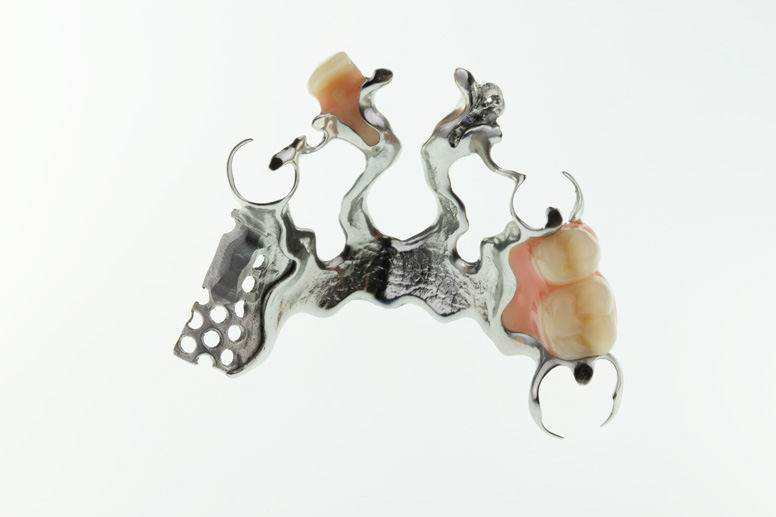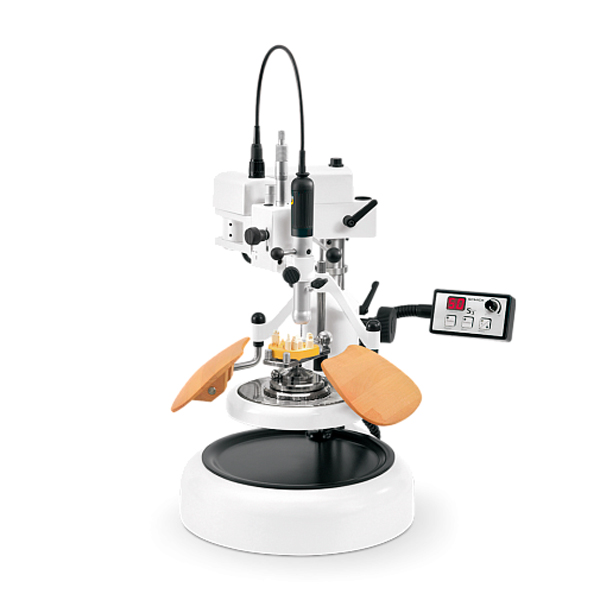Clasp dentures

Clasp dentures are a specific type of partial removable dentures. The main difference is the presence of a frame in the clasp denture, which connects several non-adjacent parts of the prosthesis with the teeth and pink aesthetics. The creation of any clasp denture consists of two stages: the production of the frame and the processing of the fragments of the partial removable prosthesis onto this frame.
The process of creating a clasp denture begins with taking a dental impression of the patient. After the impression is sent to the laboratory, an individual tray will be made for taking the next impression. When taking the second impression, the dentist must record the patient’s bite using a silicone bite block or Futar D. The method of recording the bite with wax is outdated and unreliable. We strongly recommend marking reference lines on the bite block.


However, the bite can be recorded during the first visit. This saves the patient’s time and significantly reduces the manufacturing time of the prosthesis. Thanks to this approach, we offer record production times for clasp dentures! The frame usually takes 7 to 10 days to make, while the modeling of artificial teeth and gums takes 3 to 4 days.
We offer the option of sending a set of dental arrangements to the doctor so that the patient can express their preferences regarding the shape of the teeth, while the doctor can specify the desired shade. For the creation of clasp dentures, we use only Ivoclar Ivocryl teeth!
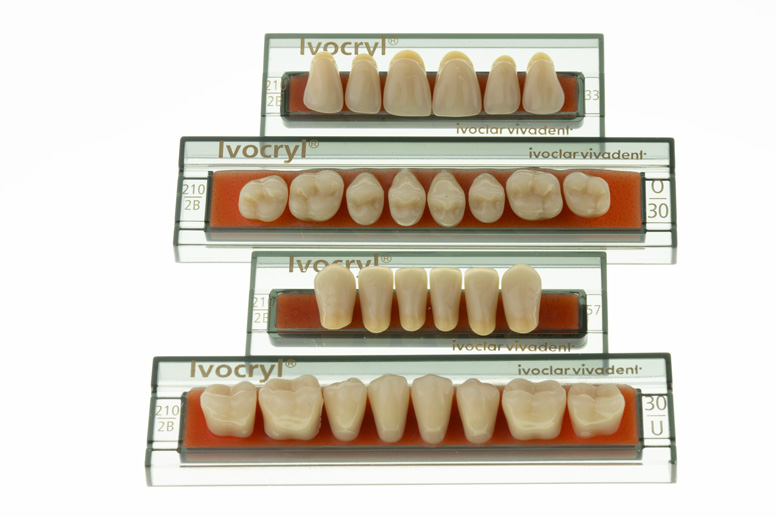
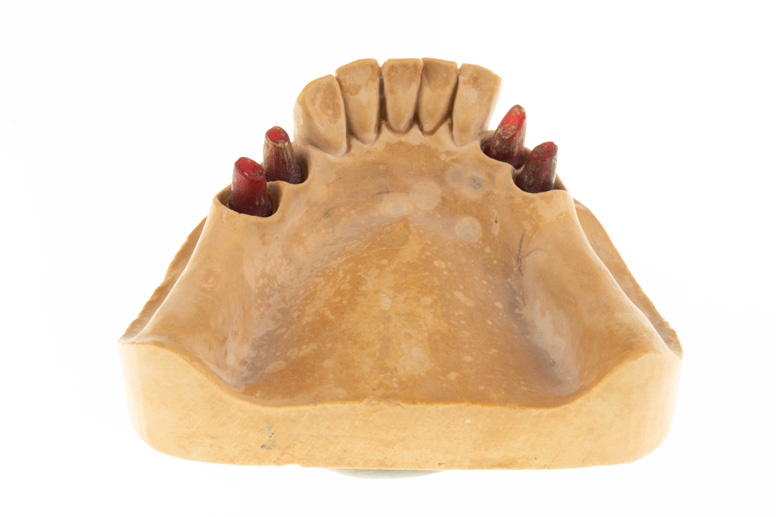
The main and most crucial stage of creating a clasp denture is making an accurate and durable frame. First, a plaster model is made based on the final dental impression. The frame can be cast from cobalt-chromium alloys or injected with Bredent Bio Dentaplast. The frame is modeled by the technician manually using wax.
The frame mainly consists of thin parts, for which meticulous precision in positioning is essential. Therefore, it is not possible to remove the finished wax model of the frame from the model and transfer it for casting in the usual way. The model will inevitably change shape even with minimal manipulation. As a result, the casting or injection of the wax modeling of the frame occurs directly on the model (the model is part of the investment or casting mold). In most cases, a plaster model is unsuitable for this purpose. For this reason, after plastering, an impression of the model is made using special silicone, and an identical refractory model (duplicate) is cast from a suitable material. The technician carries out the wax modeling on the refractory model.
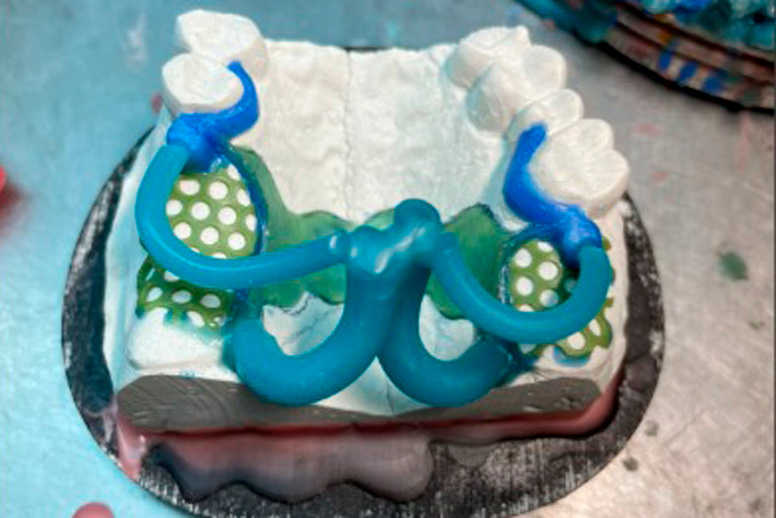
It is important to model the surface of the prosthesis so that it feels natural in the mouth, which is why the arcs for the lower jaw are made smooth, and the palatal part of the frame for the upper jaw is rough and textured. The frame of the lower jaw should not interfere with the tongue, so a thin arch of the frame passes under the dental arch. If the remaining natural teeth are firmly held, the arch is made smooth and passes along the gums. Otherwise, the frame is made as a splint. This means that the edge of the frame will follow the contour of the dental arch and touch the base of each tooth.
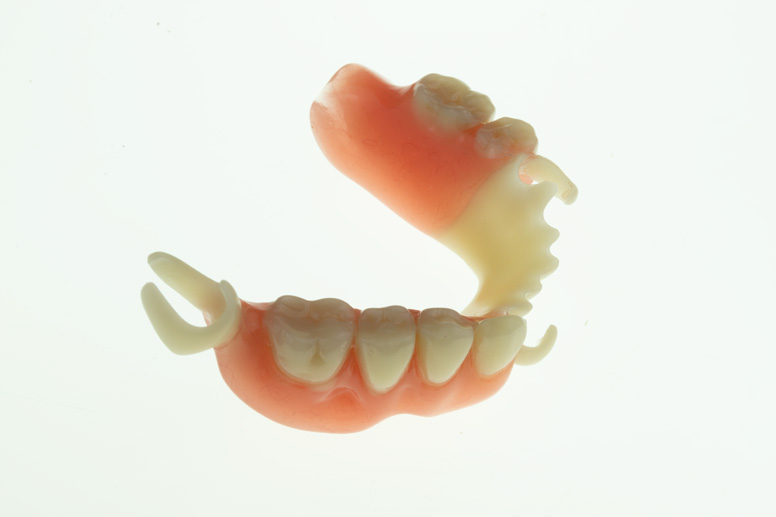
Types of work
USD
60213
ČSN OST. H. – skeletová, s litou stabilizačně
spojovací deskou – 2 kotevni prvky
5100
60214
ČSN OST. H. – skeletová, s litou stabilizačně spojovací deskou – 3 a vice kotevních prvků
5200
60235
Metal clasp denture (lower, bar + 2 clasps)
$ 220
60236
Metal clasp denture (lower, bar + 3 or more clasps)
$ 200
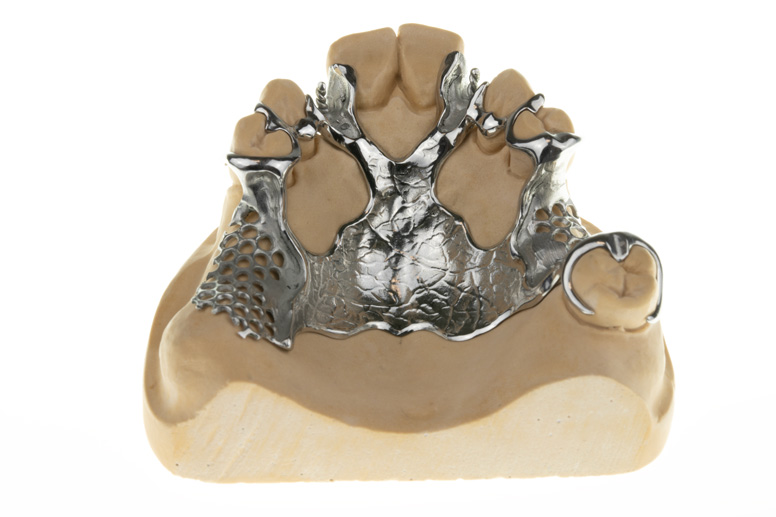
Types of work
USD
60213
Metal clasp denture (upper, bar + 2 clasps)
$ 220
60214
Metal clasp denture (upper, bar + 3 or more clasps)
$ 220
60215
ČSN OST. H. – skeletová, se spojovacím
předozadním třmenem – 2 kotevní prvky
5100
60216
ČSN OST. H. – skeletová, se spojovacím
předozadním třmenem – 3 a vice
kotevních prvků
5200
60233
Metal clasp denture (lower, bar + 2 clasps)
$ 220
60234
Metal clasp denture (lower, bar + 3 or more clasps)
$ 220
The design of a clasp denture is such that it cannot be held in place solely by adhesion. The frame of the clasp denture is always attached to the remaining teeth of the patient. There are two main attachment methods: clasps and attachments. Clasps are made from the same material as the frame and are a structural part of it. The main issue with clasp attachments is that over time, the tightness of the clasps’ thin arms around the teeth decreases. If the clasps are cast, the metal gradually straightens during use, losing strength after multiple adjustments and bends. Flexible clasps made from Bio Dentaplast do not have the same issues as cast clasps, but they are much softer. As a result, their surface gradually wears against the tooth surface, and the clasp’s tight fit is also reduced. However, this does not mean that the clasp approach is of low quality or has a short lifespan. The description of the drawbacks is comparative in nature.
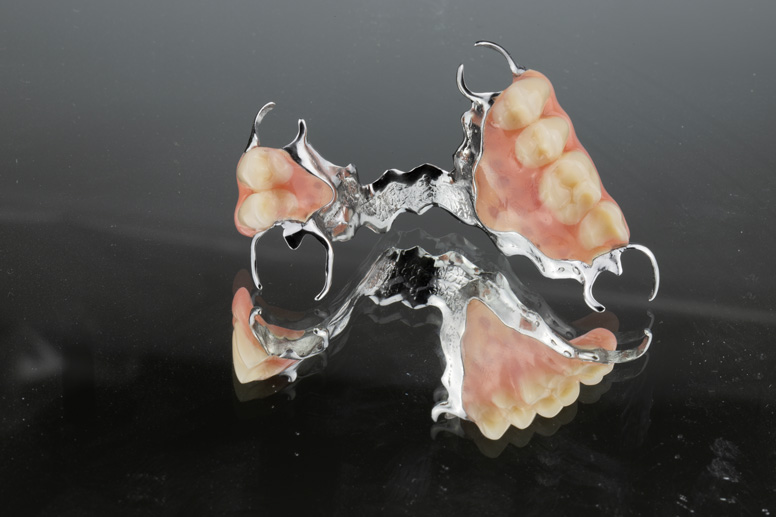
60242
Clasp denture (upper, Bio Dentaplast)
$ 230
60243
Clasp denture (lower, Bio Dentaplast)
$ 230
The use of attachments is only possible for cast frames. In order to install an attachment, a metal-ceramic structure needs to be placed on one or more of the patient’s teeth. Usually, such a structure is a crown or a bridge of several units. During the wax modeling of the metal frame of this structure, a wax counterpart of the attachment is attached to it. The wax counterpart is then fixed to the frame of the clasp denture, ensuring proper alignment of the parts.

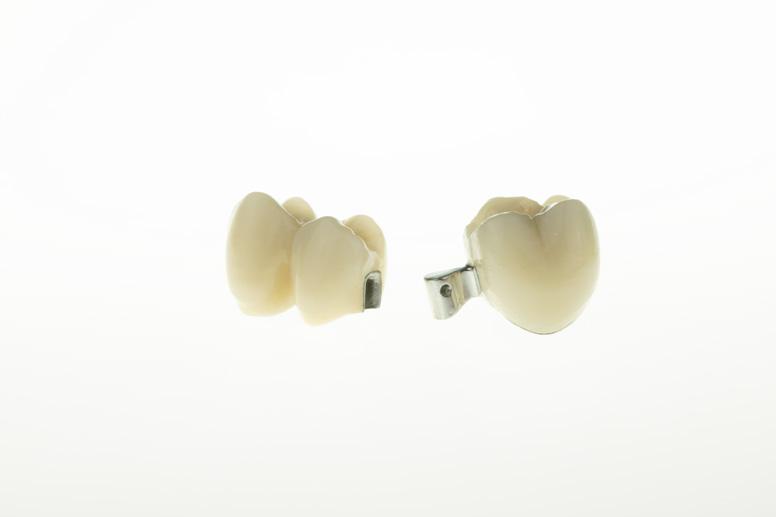
During casting, the attachment components may still be slightly misaligned and may lose their mutual fit and parallelism. Therefore, the cast attachment components are processed on the SCHICK S3 Master milling machine-parallelometer. The technician mills the lateral surfaces of the attachment with a bur fixed vertically in the machine, moving strictly parallel. After this treatment, defects in shape and parallelism will be eliminated.
-
SCHICK S3 Master
SCHICK S3 Master is a high-precision paralleling device designed for use in dental laboratories. Its design focuses on ergonomics and comfort, allowing technicians to work in a relaxed state while achieving optimal milling results.
The most popular forms of attachments are “rail” and “ball.” When the finished clasp denture is put on, the attachment provides a much more secure connection between the structures than a clasp. However, attachments do not provide perfect fit since they are also prone to metal wear in the contact zone. To address this issue, a plastic insert is placed between the counterpart parts, which needs to be replaced periodically during follow-up visits to the doctor.
60217
Clasp denture (upper, frame without attachments)
$ 220
60237
Clasp denture (lower, with Bredent Patrice / Matrice attachments)
$ 220
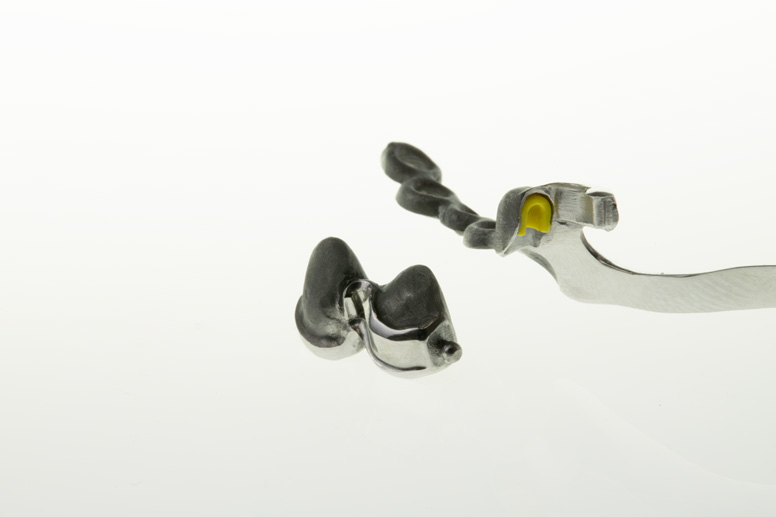
120801P
Attachment, zásuvný spoj – Patrice
600
120802M
Attachment, zásuvný spoj – Matrice
600
One way to further increase the attachment fit is to mill part of the crown placed on the patient’s natural tooth. For the part of the metal frame extending from the crown, a corresponding part is created on the frame of the clasp denture. This contact zone is made on the underside and covers a fairly large area. It is milled with the SCHICK S3 Master parallelometer. The metal surface in the contact area is polished to a shine. The fit is very tight, and no spacers are used. To date, this is one of the most popular ways to create a clasp denture, with virtually no play observed.
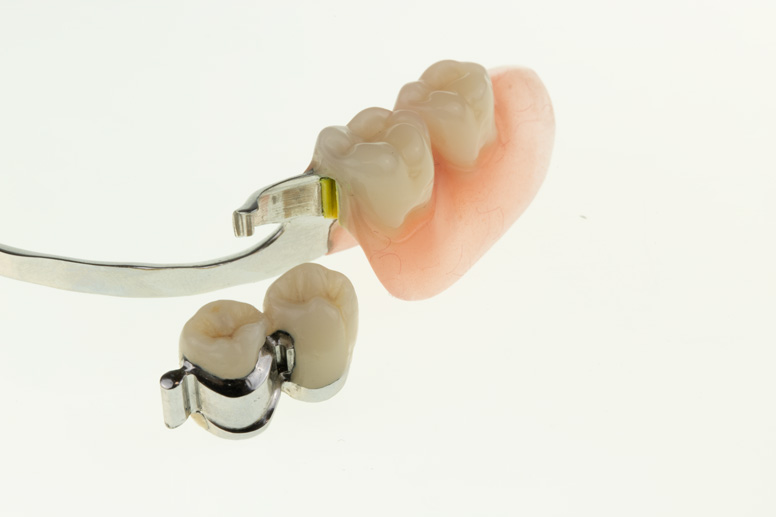
60217V
Clasp denture (upper, frame with 2 attachments + 2 milled slots)
$ 270
120801
Bredent Patrice locator attachments (with milling and interlock)
$ 50
120802
Bredent Matrice locator attachments
$ 50
An even more complex construction is the clasp denture on telescopic crowns or small bars. The difference is that a primary telescope or a bar on 2-3 natural teeth is placed, while the counterpart is integrated into the metal framework of the clasp denture. Telescopic crowns, like milling, have a tight surface fit, while bars use plastic inserts. When using any of these constructions, the need for lock attachments disappears. You can learn more about bars and telescopic crowns on the page for hybrid prostheses.
-
Hybrid dentures
: Hybrid denturesModern solutions for dental restoration: a combination of implants and removable structures.
Types of work
USD
120803
Bar support point
$ 170
120804
Telescopic crowns
$ 155
120805
Teleskopický nesponový kotevní
prvek – Kov/Kov
2350
120806
Teleskopický nesponový kotevní
prvek – Zirkon primarrní
2500
120808
Teleskopický nesponový kotevní prvek – Kov/Kompozitní plast
3000
120809
Teleskopický nesponový kotevní prvek – Kov/Metalokeramika
3300
120811
Teleskopický nesponový kotevní prvek – PEEK DEFLEX
2800
120812
Teleskopický nesponový kotevní prvek – BioHPP BREDENT frezovaní
3000
Once the frame is ready, it is sent for a try-in in the patient’s mouth. If the try-in is successful, the process of waxing the teeth and injecting plastic for the artificial gums follows. More about waxing and related technologies can be found on the removable prosthetics department page. The main difference is that instead of the reinforcement of a full denture, a pre-made metal framework of a clasp denture is used. After processing the teeth and gingiva, the finished denture requires minimal post-processing and polishing.
-
Removable dentures
: Removable denturesFabrication of removable dental structures for restoring the function and aesthetics of missing teeth.
